Brand Management Final
1/57
There's no tags or description
Looks like no tags are added yet.
Name | Mastery | Learn | Test | Matching | Spaced |
|---|
No study sessions yet.
58 Terms
Brand Elements (5)
Components that identifies and differentiates brands. This includes name, logo, symbol, characters, slogan, jingles, packaging design, color scheme, etc.)
Brand v.s. Product
Brand has dimensions that differentiate it some way from other products designed to satisfy the same need.
Product is a good or service for use or consumption, designed to satisfy a need in the market.
Functions provided by brands to consumers and firms
Consumers:
Identify source of products
Simplify product decisions
Lower the search costs for products externally and internally
Signal of quality
Helps set expectations about what consumers may not know about the brand.
Firms:
Simplify in handling and tracing
Simplify inventory and accounting process
Provide legal protection for unique brand features
Simplify expectation of demand and creates an entry barrier for upcoming brands
Creates competitive advantage
Challenges to Brand Builders (5)
Maturing markets
Growth of private labels
Difficulty in differentiating
Savvy markets
Increasing competition
Brand Equity
A value premium that a company generates from a product with a recognizable name compared to a generic equivalent. It reflects the added value that brand awareness and loyalty provide to a product. w
Factors affecting brand equity (6)
Brand Image
Brand Awareness
Brand Association
Consumer Perception
Brand Identity
Brand Loyalty
What is a brand? What is the function of a brand?
A name, form, sign, symbol, design or a combination of them.
It is intended to:
Identify the goods and services of one seller or a group of sellers
Differentiate from competitors
Create a certain amount of reputation, awareness, prominence in the market.
What is Consumer-Based Brand Equity (CBBE)?
Approaches brand equity from the perspective of the consumer, emphasizes that the power of a brand lies i the minds and hearts of consumers.
Marketing advantages of strong brands (11)
Improved perception of quality
Improved loyalty
Less vulnerability to competitive marketing activities
Less vulnerability to marketing crises
Larger margin
More inelastic to price increase
More elastic to price decrease
Greater trade cooperation and support
Increased marketing communication effectiveness
Licensing opportunities
Additional brand extension opportunities
Brand Value Chain
Marketing Program Investment (Product, communications, trade, employee, etc.)
Program Multiplier (distinctiveness, relevance, integrated, value excellence)Customer Mindset (Awareness, associations, attitudes, attachment, activity)
Customer Multiplier (competitive reactions, channel support, customer size and profile)Market Performance (price premiums, price elasticity, market share, expansion success, cost structure, profitability)
Market Multiplier (market dynamics, growth potential, risk profile, brand contributionShareholder Value (Stock price, P/E ratio, market captialization
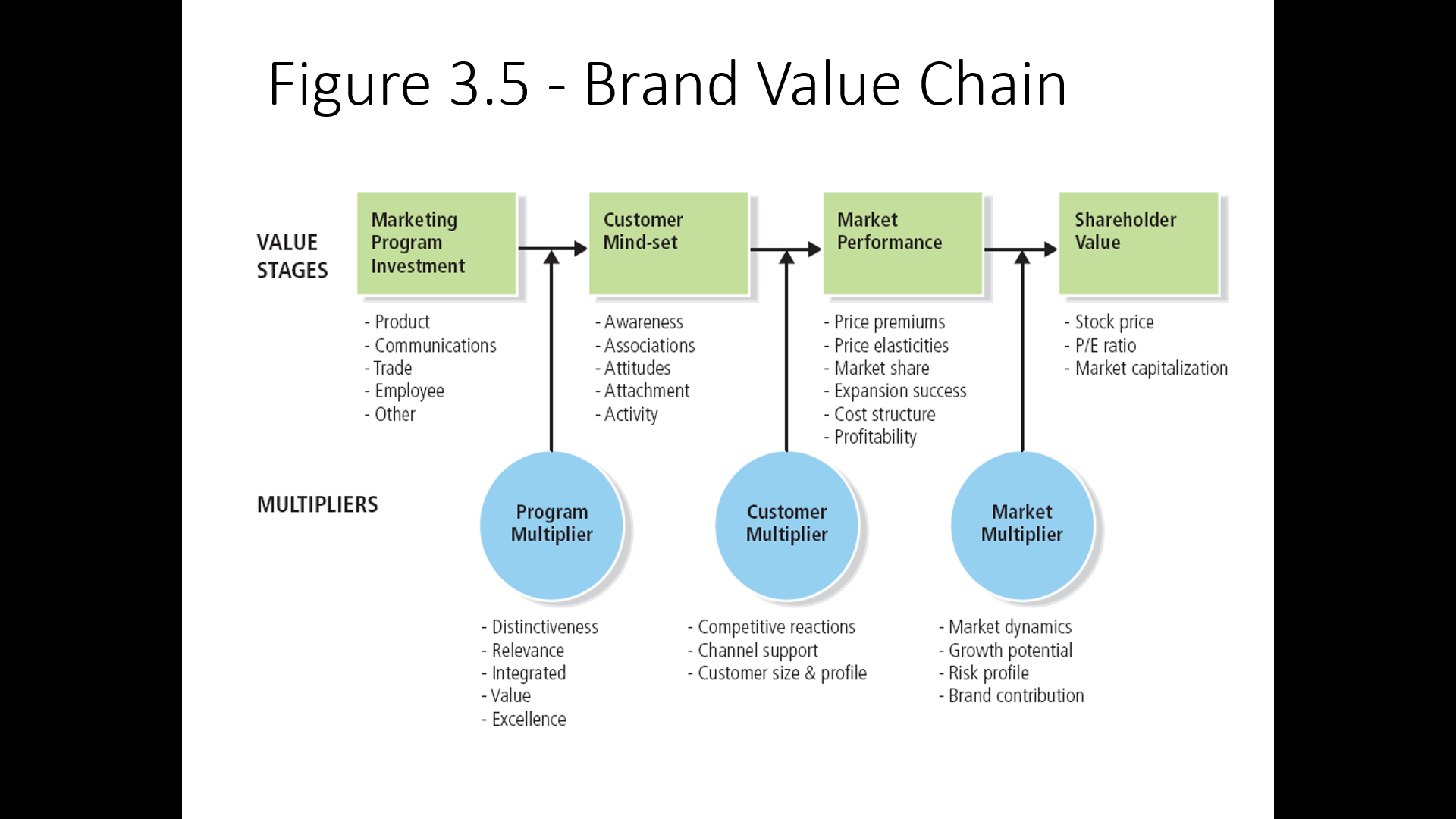
Identify and explain Keller’s CBBE Model
Salience (Identity: Who are you, deep broad brand awareness)
Performance & Imagery (Meaning: What are you, points of parity and difference
Judgement & Feelings (Response: What about you, positive, accessible reactions)
Resonance (Relationships: What about you and me, intense active loyalty)
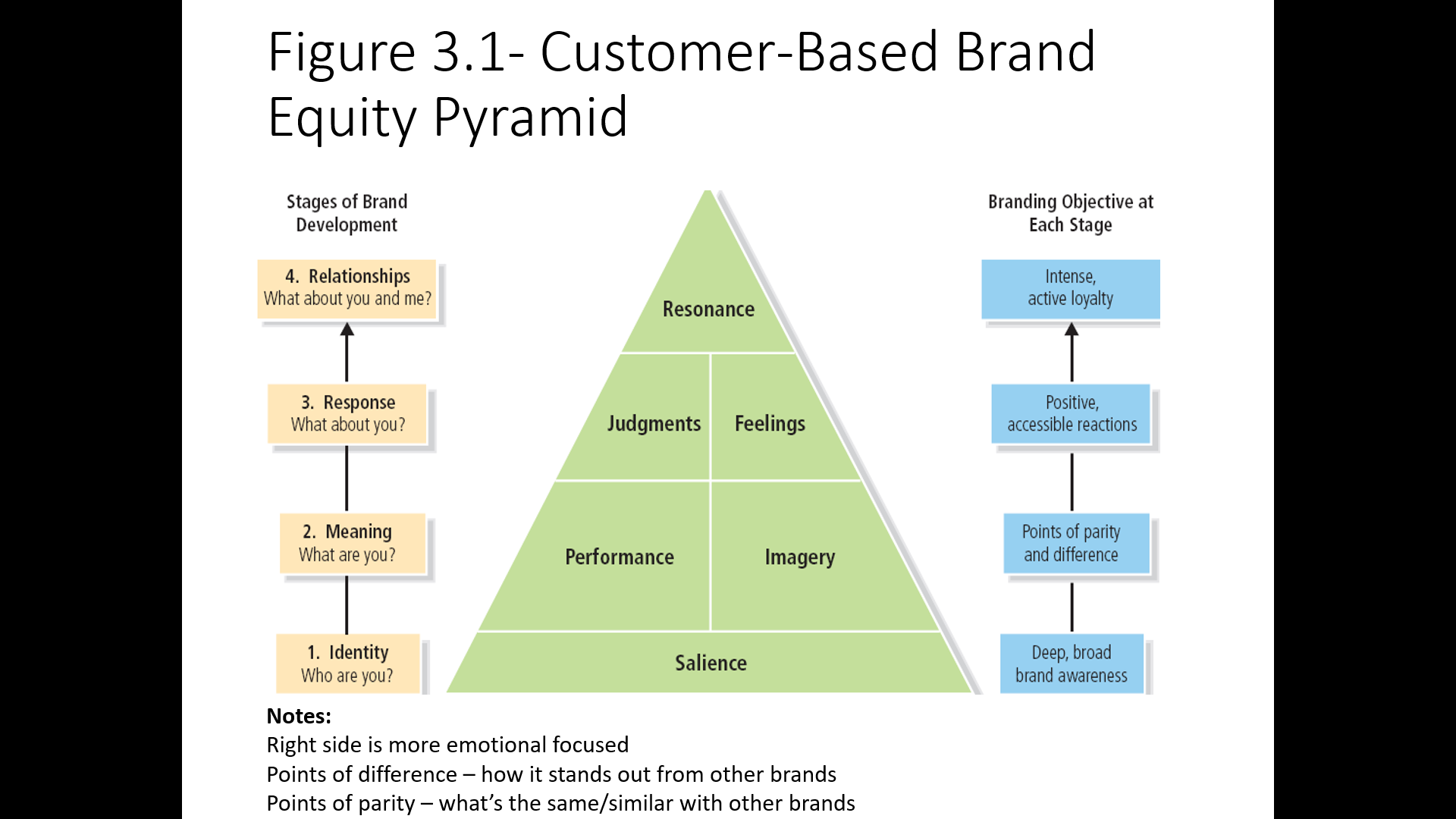
Brand Salience
Measures various aspects of the awareness of a brand:
To what extent is the brand top-of-mind and easily recalled or recognized.
Brand salience is a measure of how likely a consumer is to think of a brand when they are making a purchase.
First step in brand building:
Ensure identification of the brand with customers and an association of the brand in customers minds with a specific product class, product benefit or customer need.
Brand Performance
Describes how well the brand:
Meets consumers functional needs
Meets quality assessments
Product reliability, durability, service effectiveness
Efficiency and empathy
Style and design
Price
Brand Imagery
User profile/Imagery
Purchase and usage situations
Brand personality and values
Brand history, heritage and experiences
Brand Judgements
Quality
Credibility
Consideration
Superiority
Brand Feelings
Customers emotional responses and reactions to the brand
Brand Resonance
Behavioral loyalty
Attitudinal attachment
Sense of community
Active engagement
Criteria for choosing brand elements (6)
Memorable
Meaningful
Likable
Transferable
Adaptable
Protectable
M.M.L.T.A.P
Slogans
Short phrases that communicate descriptive of persuasive information about a brand.
Function as useful hooks or handles to help consumers grasp the meaning of a brand.
Jingles
Musical messages written around the brand
Have catchy hooks and choruses that become permanently registered in the minds of listeners
Enhances brand awareness by repeating the brand name in clever and amusing ways
New perspectives and developments in marketing, and factors that affect it
Approaches:
Rapid technological advancements
Greater customer empowerment
Fragmentation of traditional media
Growth of interactive and mobile marketing options
Factors:
Channel transformation and disruption
Increased competition
Globalization
Heightened environmental, community and social concerns
Severe economic recession (e.g. pandemics)
Co-branding
Two brands work together to create a new product with both brand names attached to it.
Co-marketing
Strategy where two brands work together on a one-off marketing campaign or promotion.
Marketing Communication, and how it contributes to brand equity (4)
Means by which firms attempt to inform, persuade and remind consumers about the brands they sell
Can contribute to brand equity by:
Creating awareness
Linking points of parity and difference in customers’ memory
Eliciting positive brand judgements
Facilitating stronger brand-consumer connection (brand resonance)
List the informational processing model of communications (6)
Exposure - seeing/hearing communication
Attention - noticing communication
Comprehension - understanding intended message
Yielding - responding favorably to message
Intentions - planning to act in the desired manner of communication
Behavior - actually acting in the desired manner
Role of having multiple marketing communication methods (2)
Optimal utilization of monetary and other resources
Different communication options also may target different market segments
3 steps of testing marketing communication effectiveness
What is your current brand knowledge? Have you created a detailed mental map?
What is your desired brand knowledge? Have you defined optimal points of parity and difference and a brand mantra?
How does the communication option help the brand get from current to desired knowledge with consumers?
4 marketing communication options
Advertising and promotion
Interactive marketing
Events and experiences
Mobile marketing
List 7 different channels of communication in the marketing communications mix
Advertising
Personal Selling
Interactive Marketing
Direct Marketing
PR and Publicity
Sales Promotion
Events and Experiences
What is ‘points of parity’ and ‘points of difference’?
Points of Parity (PoP): Features a brand must have to compete in its category, like basic expectations (e.g., all smartphones need a good camera).
Points of Difference (PoD): Unique features or benefits that set a brand apart from competitors (e.g., Nike's focus on empowering athletes with Just Do It).
Advantages and disadvantages of sales promotion (9)
Advantages:
Sense of urgency
Allows manufacturers to lower prices for price-sensitive consumers
Encourage trade to maintain full-stocks to support merchandising efforts
Builds brand equity from the actual product experience
Disadvantages:
Subsidize buyers who would’ve bought the product anyway
Decrease in brand loyalty
Decrease in quality perception
Highlights importance of price as a factor when choosing a product
Inhibit franchises
Types of advertising media (5)
Television
Radio
Print
Direct Response
Place
8 ways to leverage secondary brand associations
Companies (through branding strategies)
Countries (identify product origin)
Channels of distribution (image transfer from e.g. retailers, like Watsons)
Other brands (co-branding)
Characters (licensing)
Spokespersons (endorsements)
Events (sponsorships)
Other third party (awards or reviews)
C.C.C.O.C.S.E.O
Brand Audit
A comprehensive examination of a brand to discover its sources of brand equity.
Marketing Audit
Independent examination of a company’s marketing environment, objectives, strategies and activities.
Why is brand audit important? (4)
Assess strengths and weaknesses
Align brand and product to expectations
Meet target demographic
Learn about current brand position and how to improve
Brand Inventory and examples (7)
Purpose of brand inventory
A comprehensive and systematic catalog of all branding assets, marketing efforts and touchpoints used by a brand.
This includes:
Brand elements
Marketing materials
Product packaging and design
Digital presence
Sponsorships/partnerships
Distribution channels
Pricing strategies
Purpose: Overview of how a brand is currently presented in the marketplace. The aim is to have a consistent, coherent and recognizable brand across all platforms and channels
Difference between brand equity and brand value
What does it focus on:
Brand Equity: Perceptions, intangible brand assets
Brand Value: Financial resources
How do you assess it:
Brand Equity: Brand awareness, perceived quality, brand associations, customer lifetime value
Brand Value: Financial valuation methods (market research)
What is it used for:
Brand Equity: To determine the value that the brand’s name, logo, etc. brings to a product or service
Brand Value: Financial reporting
Explain John Robert’s Brand Positioning Model
Qualitative and quantitative research techniques
Free Associations
Projective Techniques
Zaltman Metaphor Elicitation Technique (ZMET)
Neural Research Method
List and explain (examples, advantages and disadvantages) of the 2 direct comparative methods of measuring brand equity based on a brand's market performance.
Brand-based comparative approaches: Focuses on the brand itself while keeping the product constant.
Example: Testing consumer reactions to identical products with different brand names (e.g., Coca-Cola vs. Pepsi).
Advantages:
Isolates the brand's value.
Useful for assessing new marketing changes.
Realistic evaluation.
Disadvantages:
May distort product characteristics.
Marketing-based comparative approaches:
Focuses on the marketing mix while keeping the brand constant.
Example: Testing how different pricing or advertising strategies affect perceptions of the same brand.
Advantages:
Ease of implementation
Disadvantages:
Hard to separate brand knowledge from product knowledge.
Conjoint Analysis (definition, advantages and disadvantages)
Survey-based multivariate technique that enables marketers to profile the consumer decision process with respect to products and brands.
It works by breaking down a product or service down into its components (attributes) and testing different combinations to identify the ones are more and less preferred.
Advantage:
Study different brands and different aspects of the product or marketing program simultaneously
Disadvantages:
Marketing profiles may violate consumers’ expectations based on what they already know about brands.
Difficult to specify and interpret brand attribute levels
List and explain the 2 approaches of holistic methods
to measure brand equity
Holistic methods evaluate a brand's overall value by considering all aspects of its performance, including consumer perceptions, market position, and financial contributions.
Residual Approach: Calculates brand value as the difference between the financial performance of a branded product and an equivalent non-branded product.
Valuation Approach
A broader framework encompassing various methods used to assign a monetary value to a brand.
List 4 applications of brand valuation.
Mergers and acquisitions
Brand licensing
Fund raising
Brand portfolio decisions
Brand architecture
The strategic framework that determines how a company’s brands are organized.
Explain the following brand architecture types:
House of brands
Branded house
Sub-brands
Endorsed brands
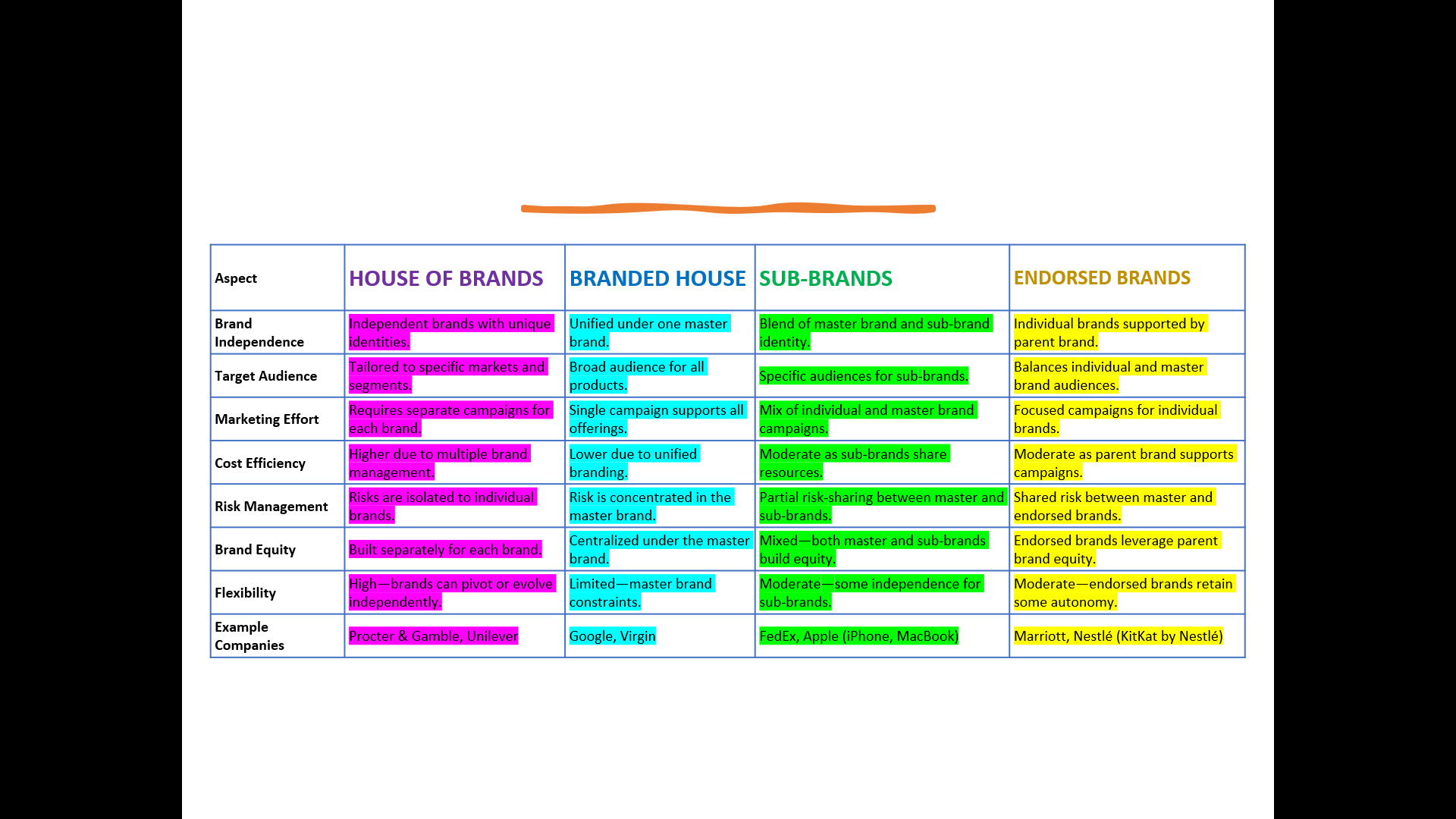
Steps in developing a brand architecture strategy
Step 1: Define brand potential
Brand vision, boundaries and characteristics
Step 2: Identifying brand extension opportunities
Brand extension is a new product introduced under an existing brand name
Line extensions: Same category but variations in features like flavor, size, color, or form. Example: Coca-Cola, Coke Zero, Diet Coke
Category extensions: New product category
Example: Apple - phones, watches, airpods
Step 3: Branding New Products and Services
What is the purpose of points of parity and points of difference in brand extension?
POP: Ensures that the brand extension meets the basic requirements or expectations of the new category.
Example: Coke Zero ensured the ‘zero sugar’ feature aligned with the diet soda category.
POD: Creates a unique competitive advantage and distinguishes the brand extension from competitors.
Example: Apple iPhones have a robust app ecosystem, setting it apart from other smartphones.
Why might a firm have multiple brands in the same product category?
Market coverage
List 9 possible special roles of brands in the brand portfolio.
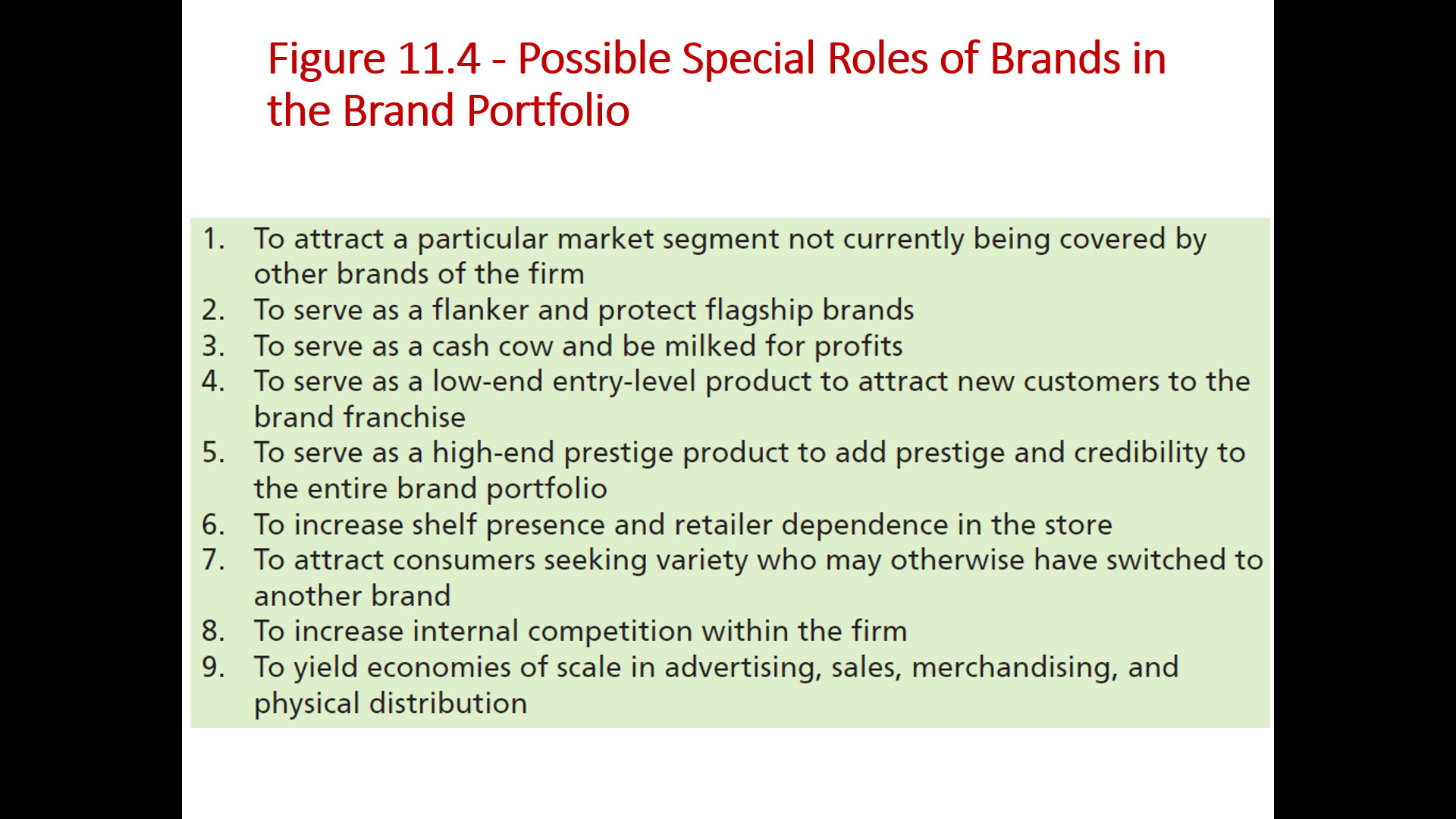
What are the 5 levels of brand hierarchy?
Corporate Brand
Definition: The highest level, representing the entire organization.
Example: Procter & Gamble (P&G).
Family Brand
Definition: A brand name used across a range of related products.
Example: Nivea for skincare products (lotions, creams, deodorants).
Individual Brand
Definition: A unique brand name for each product line to target specific markets.
Example: Tide (a P&G brand).
Modifier
Definition: Describes a product variation under an individual brand.
Example: Tide Pods or Tide Liquid Detergent.
Product Descriptor
Definition: Clarifies the product's function or purpose.
Example: Tide Pods Laundry Detergent.
Brand revitalization: what are the 2 brand reinforcement strategies?
Expanding brand strategies
- Identifying additional or new usage opportunities
- Identifying new and completely different ways to use the brandImproving brand image
- Identifying target market
- Repositioning the brand
- Changing brand elementsAdjustments to brand portfolio
- Migration strategies
- Acquiring new customers
- Retiring brands
List 10 brand revitalization strategies
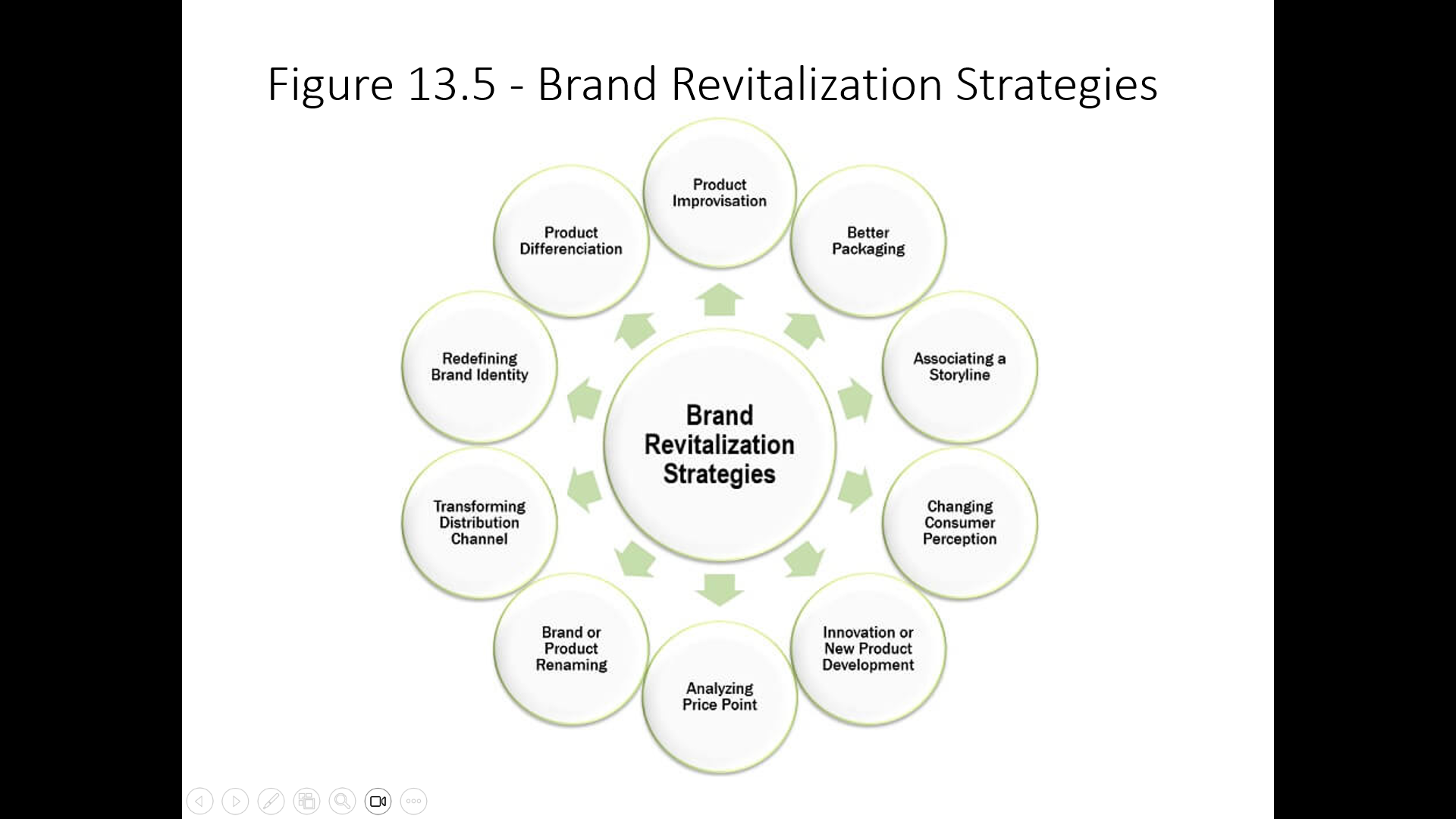
What is the depth and breadth of brand awareness?
Depth of brand awareness: Determined by the ease of brand recognition and recall
Breadth of brand awareness: Determined by the number of purchase and consumption situations for which the brand comes to mind.
What makes a strong brand?
Understand brand meaning and market appropriate products and services in an appropriate manner
Properly position the brand
Provide superior delivery of desired benefits
Employ a full range of complementary brand elements, supporting marketing activities, and secondary associations
Embrace integrated marketing communications and communicate with a consistent voice
Measure consumer perceptions of value and develop a pricing strategy accordingly
Establish credibility and appropriate brand personality and imagery
Maintain innovation and relevance for the brand
Strategically design and implement a brand architecture strategy
Implement a brand equity management system
Brand awareness
Related to the strength of the brand node or trace in memory, as reflected by consumers’ ability to recall or recognize the brand under different conditions.
Brand image
Consumer perceptions of and preferences for a brand, measured by the various types of brand associations held in memory.
Difference between marketing and branding
Marketing is the process of promoting and selling products or services through strategies like advertising and social media, focusing on short-term goals to generate demand and awareness.
Branding, on the other hand, is about creating a unique identity, including logos, values, and messaging, to build long-term trust and loyalty with customers. While marketing attracts customers, branding ensures they stay loyal by defining who the business is and why it matters.